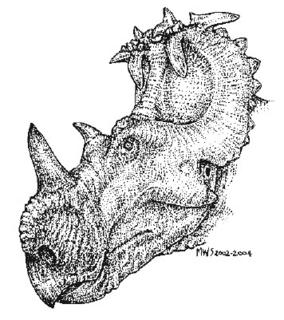Centrosaurus brinkmani

A new centrosaurine ceratopsid from the Oldman Formation of Alberta and its implications for centrosaurine taxonomy and systematics.
Ryan, M.R. and Russell, A.P. (2005). Can. J. Earth Sci. 42: 1369–1387.
Abstract: "Centrosaurus brinkmani" (sp. nov) is distinguished from "Centrosaurus apertus" by key features of its cranial ornamentation, including the shape and orientation of the postorbital horn and parietal ornamentation at parietal locus 3, the shape of the parietal ornamentation at locus 2, and the possession of accessory parietal ossifications developed as short spines on the caudal parietal ramus. This species is restricted to the Oldman Formation of southern Alberta and is the oldest ceratopsid represented by diagnostic material in Canada. Phylogenetic analysis of the Centrosaurinae suggests that the development of spike-like ornamentation at the parietal locus 3 parietal locus is inversely related to the development of the P1 parietal ornamentation."













<< Home